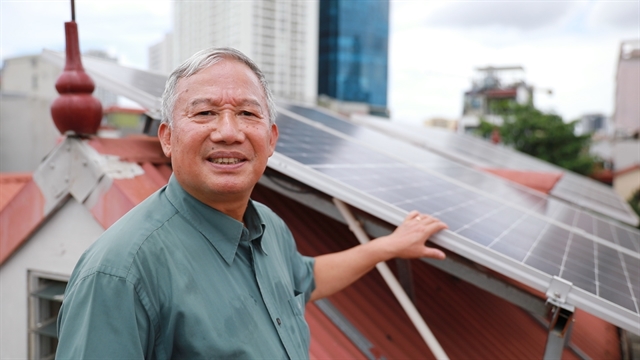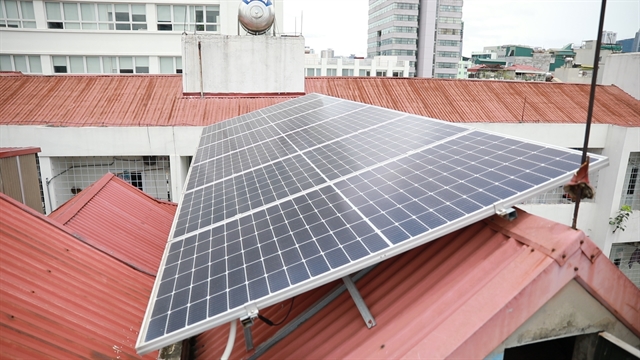 Society
Society

Bảo Hoa
* with additional reporting by Bảo Ngọc, Nhật Hồng & Minh Phương
HÀ NỘI — Although there is less sunshine in northern Việt Nam than in other regions, some Hà Nội residents are still happy with the electricity their rooftop solar power systems produce.
Statistics from the Vietnam Energy Association showed the north enjoys only 1,500-1,700 hours of sunshine a year compared to 2,000-2,600 hours in the central and southern regions.
This gives areas in the northern region, the capital city included, a natural disadvantage when it comes to solar energy production.
However, some residents, who installed solar panels on their rooftops to produce electricity, didn’t find this a very big challenge.
Trần Quang Phục, a resident of Tây Hồ District, invested in a system of 18 panels in 2018.
“It’s been three years since they were installed, and I’ve never encountered any problems,” he said. “It benefits me economically since my electricity bill was reduced a lot, about tens of per cent, sometimes even 50 per cent.”
 |
| Trần Quang Phục inTây Hồ District paid around VNĐ140 million (US$6,014) to install a system of 18 solar panels on his rooftop in 2018. — VNS Photos Bảo Hoa |
Phục decided to install the panels since he knew there would be several advantages.
“When I heard about solar energy from the news, I wanted to be part of the scheme to produce solar electricity,” he said. “Because, first, we will be entitled to cheap electricity and second, we will contribute to making the air cleaner and reduce the use of coal and oil, because using clean energy is a trend now, even cars run on batteries.”
He added: “The central region might be better for developing solar energy because it has more sunny hours all year round than the north. But that doesn’t mean we shouldn’t develop solar energy in the north.
“Speaking from my family’s experience, we can still produce electricity even on cloudy days, just not as much as on sunny ones. So the average amount produced in a year is not much lower than in the central region.
“If it’s 100 per cent in the central region, in the north it can be 70-80 per cent. It’s still a good investment.”
Nguyễn Hồng Quang in Đống Đa District had 12 solar panels mounted on his iron roof.
“Solar energy is something I’ve always cared about, because I care about environmental issues and how to take advantage of natural resources that don’t harm the environment,” he said.
“After two years of using the system, I can definitely see the positive results. Each month I can save around 200 kilowatt-hours of electricity.
“The house is a little bit cooler inside. During the hottest hours, like at noon or in the afternoon, I can keep the air-conditioners on without feeling like I’m wasting money.”
 |
| Nguyễn Hồng Quang in Đống Đa District has 12 solar panels mounted on his iron roof, which costs him about VNĐ74 million ($3,179). |
Not only using the electricity, Quang also sold it to the national grid and earned a maximum of about VNĐ200,000 ($8.58) per month.
“Last year, I saved VNĐ7-8 million from using the electricity I produced,” he said. “I was also able to sell about VNĐ3 million of electricity to the State, so in total I earned about VNĐ10 million last year.
“If I can keep on with that, in six or seven years I will be able to gain back the money I invested, because I spent about VNĐ74 million on this system.”
Trần Hào, a representative from Green Energy Viet Nam Production and Trading Co., Ltd, a Hà Nội-based solar energy equipment supplier, said that having fewer sunny hours shouldn’t be a reason that prevents people from developing solar energy in the north.
“We have less sunshine in the winter and spring, so it’s understandable that people think it’s not effective to get a solar power system,” he said.
“In reality, major projects that we have done in the north in recent years showed that each kilowatt of solar panels could produce 3.2 kilowatt-hours of electricity per day, while in the south it’s 4 kilowatt-hours per day.
“The north does have a lower solar radiation level than the central and southern regions, but the difference in electricity produced is not very large.
“Looking at these numbers, we can see there’s not much of a challenge to create and use a clean source of energy in the north. What’s more important is to find a supplier with expertise, and don’t try to buy cheap things.
“High-quality panels, inverters and a good installation plan will decide the performance and durability of the system.”
 |
| As the panels are mounted directly on the iron roof, Quang says they help shield it from direct sunshine and make the house cooler inside. |
Although the benefits of solar energy are undeniable, elements such as location, space and cost should be factored in when it comes to installing a rooftop solar power system.
Moreover, at the moment, the Government has not decided on the new purchase price for rooftop solar after the previous feed-in-tariff of VNĐ1,938 (8.38 cents) per kilowatt-hour expired on December 30, 2020.
Hào added: “The Ministry of Trade should decide as soon as possible the price they can afford to pay people for the solar electricity they produce.
“Considering the level of solar radiation in the north is only 80 per cent of that in the south, we hope that the purchase price for solar electricity in the north will be 20 per cent higher than the south.”
Phục from Tây Hồ said: “Banks should give loans so people can invest in solar energy systems. They can take the solar energy people produce as collateral and don’t require anything else for the loans.
“At the moment, households need to register as a business to sell solar electricity to the State, but if the State can phase out this requirement by working with Vietnam Electricity (EVN), it will enable more people to join the scheme.
“The more people produce solar electricity, the less coal and oil energy we’ll have to use.” — VNS